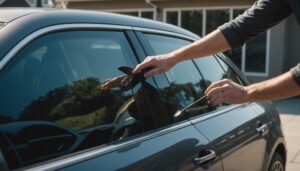If you’ve noticed scratches on your car, don’t worry; you can tackle them effectively. First, it’s important to assess the damage and identify the type of scratch. This will guide your next steps and help you gather the right supplies. From basic scratch removers to touch-up paint, knowing what you need is essential for a successful repair. Let’s explore the best solutions to restore your car’s appearance without going to a pro.
Key Takeaways
- Assess the scratch type to determine the appropriate repair method, focusing on light, medium, or deep scratches.
- Gather necessary supplies such as microfiber cloths, scratch repair kits, and touch-up paint specific to your car’s color.
- Clean the scratched area thoroughly to ensure proper adhesion and prevent further damage during repair.
- For minor scratches, apply scratch remover products following the instructions, and buff with a microfiber cloth.
- For deeper scratches, use touch-up paint and clear coat for blending and protection, lightly sanding between applications if needed.
Assessing the Damage: Identifying the Type of Scratch
When it comes to fixing scratches on your car, the first step is evaluating the damage by identifying the type of scratch. Start by examining the scratch closely. Light scratches, often referred to as clear coat scratches, don’t penetrate deeper than the clear coat layer. You can usually feel these with your fingernail but they don’t go into the paint.
Next, check for medium scratches. These may reach the paint, and you’ll feel them a bit more deeply with your nail. They usually require a bit more care. Finally, there are deep scratches that reach the metal. If you can see bare metal or feel a significant indentation with your nail, that’s a deep scratch. Knowing the type of scratch helps you choose the right repair method. Take your time evaluating the damage; it’s essential for effectively restoring your car’s finish.how-to-jump-car
Gathering Your Supplies: Tools and Materials Needed
After evaluating the damage and identifying the type of scratch, it’s time to gather the supplies you’ll need for the repair. First, you’ll require a set of microfiber cloths to avoid further scratching the paint. Next, grab a scratch repair kit that contains touch-up paint specific to your car’s color check your vehicle’s manual or manufacturer website for the exact shade. You’ll also want some fine-grit sandpaper or automotive polishing compound for deeper scratches.
Don’t forget a wax applicator or buffer to polish the area once you’ve made your repairs. If you prefer a DIY approach, consider getting rubbing compound and a clear coat for a smooth finish. A spray bottle with water can help while sanding. With these tools and materials ready, you’ll be well-equipped to tackle those pesky scratches. Remember, preparation is key to achieving the best results!
Cleaning the Area: Preparing Your Car for Repair
Cleaning the area around the scratch is essential for a successful repair. Start by washing the affected area with car soap and water to remove dirt, grime, and debris. Use a microfiber cloth to avoid scratching the surrounding paint. Rinse thoroughly to guarantee no soap residue remains, as this can interfere with your repair process.how-long-does-a-car-battery-last
Next, dry the area completely using a clean towel. Moisture can hinder the adhesion of any products you’ll apply later. After drying, inspect the scratch closely for any remaining contaminants—use rubbing alcohol or a dedicated surface cleaner to tackle any stubborn spots.
It’s also a good idea to mask off the surrounding paint to avoid accidental damage during the repair. By taking the time to clean properly, you’ll set yourself up for a smoother, more effective repair process, improving your car’s appearance and preserving its value.
Minor Scratches: Using Scratch Remover Products
Though minor scratches can be frustrating, using scratch remover products can effectively restore your car’s finish. These products come in various forms, such as creams, polishes, or pens. To get started, make sure the area is clean and dry. Apply the remover according to the manufacturer’s instructions.
Here’s a simple comparison of popular scratch remover products:
| Product Name | Application Method | Average Price |
|---|---|---|
| Meguiar’s Scratch X | Hand or machine | $10-$15 |
| Turtle Wax Rubbing | Hand application | $8-$12 |
| 3M Scratch Remover | Hand or machine | $15-$20 |
Using a microfiber cloth, gently buff the area in circular motions. Inspect your work and repeat if necessary. With patience, you can make those minor scratches vanish and enjoy a polished finish again!
Deeper Scratches: The Touch-Up Paint Process
Minor scratches can often be handled with scratch remover products, but deeper scratches require a different approach. First, you’ll need to clean the area thoroughly to remove any dirt or debris. Next, assess the scratch. If it’s deep enough to expose the metal, you’ll want to use touch-up paint that matches your car’s color.
Start by shaking the paint can to guarantee an even mixture. Using a small brush or applicator, carefully apply the paint to the scratch, slightly overfilling it. This allows for some sanding and smoothing later. Let the paint dry as per the manufacturer’s instructions.
Once it’s dry, you can lightly sand it with fine-grit sandpaper to blend the touch-up paint with the surrounding area. Finish by applying a clear coat over the repair for added protection. This process restores your car’s appearance and helps prevent rust and further damage.
Polishing and Waxing: Restoring Your Car’s Shine
While you may have successfully tackled scratches on your car, polishing and waxing are essential steps to restore its overall shine and protect the paint. Start by choosing a high-quality polish designed for automotive use. Apply it sparingly with a soft foam applicator, working in small sections. Use a circular motion, focusing on any areas that still look dull.
Once you’re satisfied with the polish, it’s time to wax. Wax creates a protective barrier against contaminants and UV rays. Choose either a liquid or paste wax, applying it with a clean microfiber cloth. Again, work in a circular motion, allowing the wax to haze before buffing it off with another cloth.
Finally, step back and admire your work. Not only will your car look great, but the wax will help keep it protected for longer, ensuring that shine lasts through the seasons.
Frequently Asked Questions
Can Professional Detailing Services Fix Deeper Scratches Effectively?
Yes, professional detailing services can effectively fix deeper scratches on your car. They have the right expertise and tools to assess the damage and choose suitable techniques, like wet sanding or polishing, to restore the finish. While some scratches may be too deep to fully remove, detailers can greatly improve the appearance. You’re likely to leave with a car that looks much better, feeling satisfied with the results of their work.
How Can I Prevent Future Scratches on My Car?
You can prevent future scratches on your car by keeping it in a garage or using a car cover when parked outside. Regularly waxing and applying sealants create a protective barrier. Also, avoid parking near shopping carts, bushes, or other vehicles. Consider using clear protective film on vulnerable areas. Finally, pay attention when washing your car to avoid using abrasive materials that could cause scratches. Taking these steps keeps your vehicle looking pristine.
What if the Scratch Is Too Deep to Repair?
If the scratch is too deep to repair, you’re usually better off seeking professional help. They can assess the damage and recommend options like repainting or applying a clear coat. You might also consider covering it with a touch-up paint or vinyl wrap for a temporary fix. Remember, ignoring it could lead to rust or further deterioration, so addressing it sooner rather than later will save you more trouble down the road.
Are DIY Methods as Effective as Professional Services?
DIY methods can be effective for minor scratches, but they often don’t match the precision and quality of professional services. You might get satisfying results with products like scratch removers or touch-up paint, but deeper scratches often require specialized techniques that only pros can provide. If you’re dealing with extensive damage or want a flawless finish, it’s usually better to invest in a professional service for the best outcome.how-much-does-it-cost-to-wrap-your-car
Will Fixing Scratches Increase My Car’s Resale Value?
Yes, fixing scratches can definitely increase your car’s resale value. Buyers often look for vehicles in excellent condition, and visible scratches might turn them away or hinder your negotiation power. By addressing these imperfections, you present a better overall appearance, making your car more appealing. It shows you’ve cared for it, which can translate into a higher price. So, investing a little time in repairs could yield significant returns when you sell.
Conclusion
Fixing scratches on your car doesn’t have to be an intimidating task. By evaluating the damage, gathering your supplies, and following the proper steps, you can restore your vehicle’s appearance with ease. Whether you’re using a scratch remover for minor blemishes or touch-up paint for deeper scratches, taking the time to care for your car will keep it looking polished. Remember to finish with a wax for that extra shine—you’ll be proud to drive your freshly repaired car!












